Engagement Ring - In Progress
Setting
Stone
We guarantee that every single purchase directly impacts one person's life by giving them access to clean water.
There’s lots of talk about diamond testers lately! From those just learning that Moissanite can “pass” as diamond to teenagers testing their teachers rings (OMG), the intrigue seems pretty universal. But are “diamond testers” all they are cracked up to be? And how can you know what you have on your finger? I’m here to let you in on the inside scoop:
When someone refers to a “diamond tester”, most people mean a handheld “pen” tester that measures a gemstone’s thermal conductivity. In other worse, how a gem handles heat. These testers use a small metal point which, when put on a gem’s surface, measure how quickly heat travels through the stone. People use these to test diamonds because diamonds have super high conductivity.
Diamond testers can be a helpful tool as part of a multi-stage test, but should not be solely relied upon. These little pens are a helpful way to separate out CZ from diamond. But that should be the beginning and end of their use. Why? Because other gems also have high conductivity (such as moissanite) and because the testers themselves notoriously malfunction. Reasons I have seen these testers fail include user error (stones will not test correctly if the point touches metal), low battery, or age/abuse of the pen.
Yes, some diamond simulants can pass a diamond tester. For example, moissanite, a man made gem, may pass as a diamond on a standard tester pen. This is because moissanite also has very high thermal conductivity! Other diamond simulants, such as CZ, will not pass the tester. So, it’s important to use multiple tests to confirm your stone!
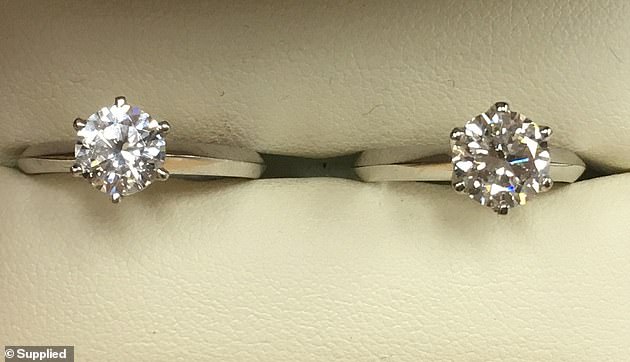
Note the CZ’s (left) lack of depth and “plasticky” reflection vs the Diamond’s (right) multi-tonal shades and crisp reflection?
The major tests jewelers use to tell real diamonds from other white stones are confirming they are singly refractive, have 10/10 hardness, and super high conductivity. Moissanite is doubly refractive under magnification, which easily separates it from diamond. CZ, white sapphire, and white topaz do not have high conductivity using a pen tester. Finally, lesser known diamond simulants do not have high hardness, which can be seen through magnification.
Yes! Rainbow sparkle in a diamond is called “fire”. There is some misinformation out there that diamonds do not show colored light – however this is false. In fact, a diamond’s ability to show a rainbow of color is one of its most prized features, and one of the reasons it is preferred by many over other white stones like white sapphire or white topaz. Moreover, diamonds show a balanced display of rainbow and white sparkle. This should be compared against moissanite and CZ’s major colored sparkle, which outshines its white sparkle.
Typically a lab diamond will test as diamond on a pen tester because they are pure carbon just like mined diamonds. Testing a lab diamond is a little more complicated than testing a natural diamond, however. That is because lab diamonds are grown using differing methods and over differing courses of time. This results in different crystal densities (and thermal conductivity levels). As a result, some lab diamonds (HPHT especially) may test as Moissanite on a diamond tester and require further testing.
Ironically, just like Moissanite can test as diamond, diamond can also test like Moissanite. This is because diamonds have a range of thermal conductivity, depending upon crystal density. This is especially true for HPHT lab diamonds. So, if this happens to you, don’t immediately assume the worst. Again, these pen testers are not foolproof. Here’s what to do:
Lab diamonds can be separated from natural diamonds by reviewing the diamond’s certificate inscription underneath a scope. Lab diamonds will be marked “lab grown” or “LG”, whereas naturals will not have these prefixes. Gem scientists are also be able to tell lab diamonds from natural diamonds using advanced magnification, fluorescence, and laser techniques.
Natural diamonds, lab diamonds, and non-diamond moissanite! This is because a handheld pen “diamond tester” actually only tests the ability of a gem to conduct heat. It does not test for whether or not the stone is, for example, pure carbon (like diamonds are). So, while the pen tester is helpful – it’s only one piece of the puzzle!
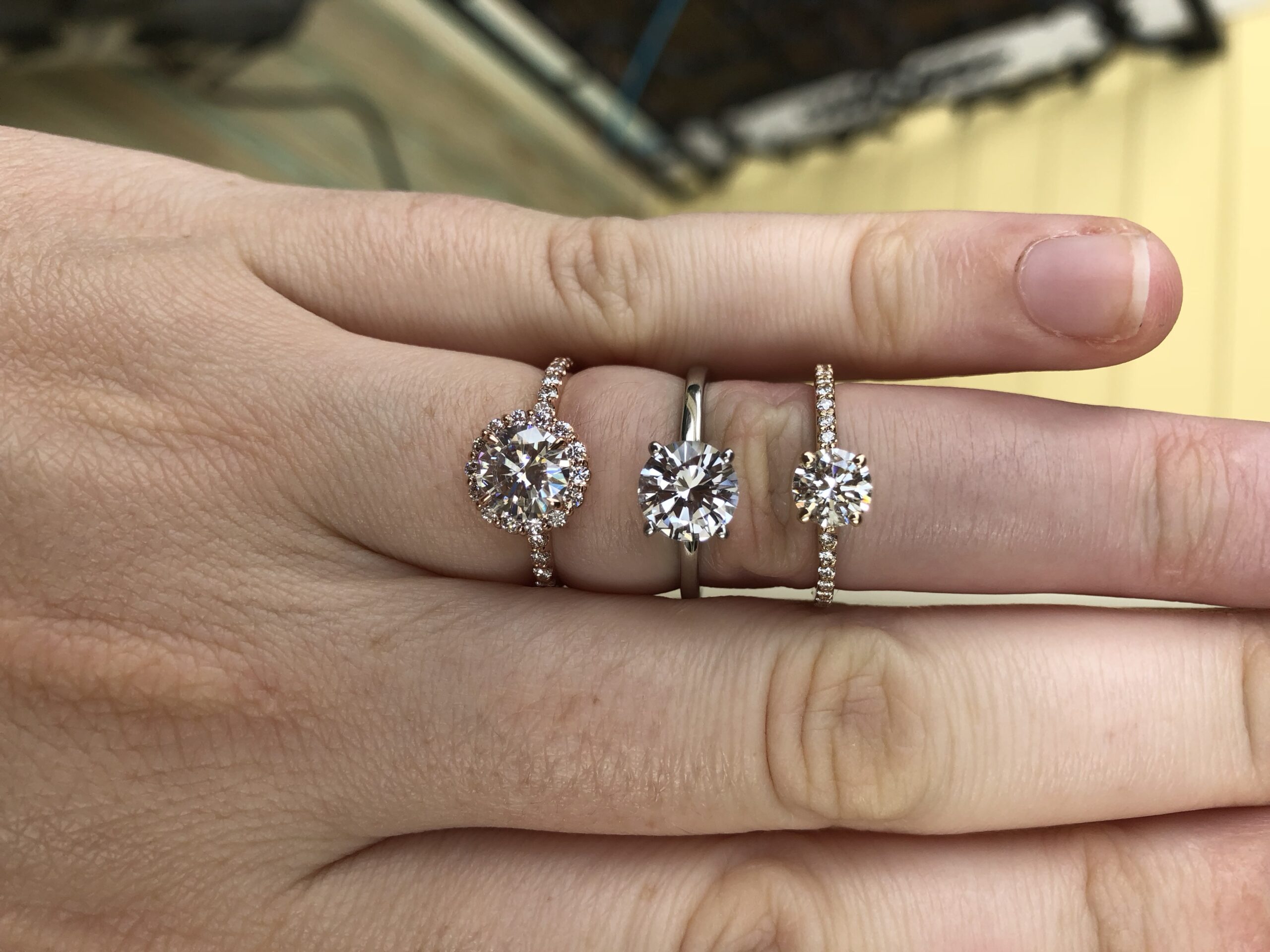
Moissanite (left) vs White Sapphire vs Diamond (right)
Some testers show a moissanite result whereas others test moissanite as diamond. It all depends upon the model of the tester. However, because of the varying levels of diamond thermal conductivity (discussed above) a test as “diamond” or “moissanite” on one of these pens only gives so much information. Once a stone tests as diamond or moissanite on a pen tester, confirming magnification tests should be performed via microscope!
There are pen testers that provide a certain result for moissanite, however, moissanite is best confirmed through viewing “doubling” under magnification. Why? Especially with the growing popularity of HPHT diamonds, which may test as moissanite on a pen tester, viewing doubling under magnification is the easiest way to conclusively separate the two. And it’s easy! Just look through the “crown” facets of the stone under a scope.
There are a few options! If you’re using a pen tester, start there to rule out diamond simulants other than moissanite. Then check for certificate or doubling! Here’s how:

No. Cubic Zirconia (or CZ) does not have high enough thermal conductivity to pass. So, when you test a CZ with a diamond tester, it will not show as diamond. In fact, distinguishing CZ from diamond is one of the most important uses of thermal conductivity pen testers.
Real diamonds test as diamond on thermal conductivity testers and most have microscopic laser inscriptions. Those are the two easiest ways to test between diamond and CZ. More nuanced tests include “pavilion flash” and “heft” – both of these require the stone to be loose. To test for pavilion flash, put your stone point side up and flash a penlight over it. If the stone flashes blue, the stone is likely CZ. And, to test for heft, weigh the stone in your hand. If it feels “too heavy” for its size, it is likely CZ (CZ weighs about twice as much as diamond).
No. White Sapphire does not have high enough thermal conductivity to pass. And, white sapphire looks quite different than diamond, moissanite, and CZ, so using a pen tester is not common. Whereas the high conductivity gems show rainbow sparkle, white sapphire shows white and silver sparkle. It also tends to have a silvery undertone. So, these are often easier ways to spot sapphire from diamond.
Whereas diamond will pass a pen test and have rainbow sparkle, white sapphire will not pass and has white and silver sparkle. Sapphire is usually faceted differently than diamond, as well, with rectangular facets on the bottom of the stone. Finally, more nuanced tests include finding the “refractive index” of the gem. Notably, white sapphire’s refractive index also helps to distinguish white sapphire from white topaz!
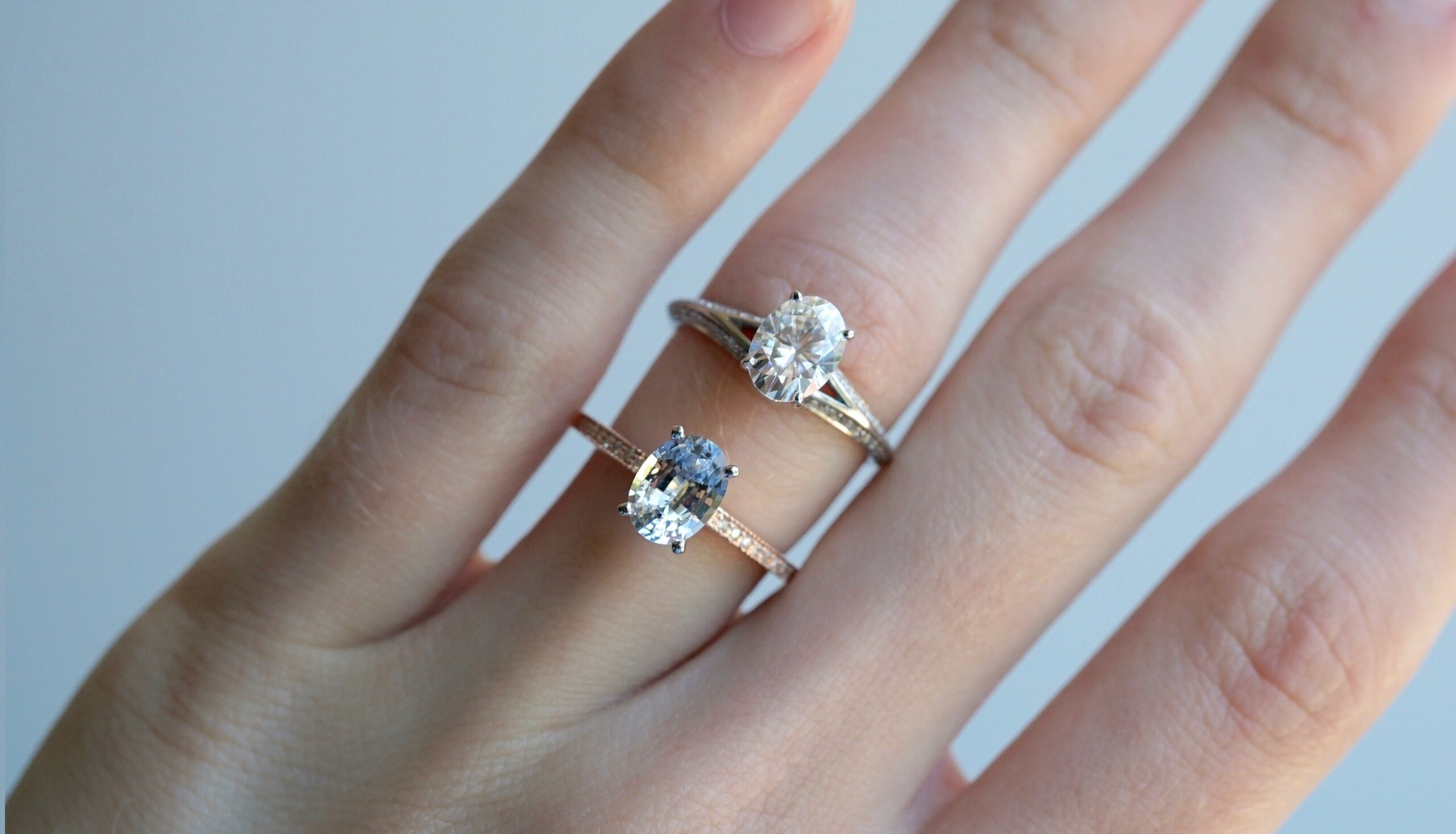
Moissanite (top) vs White Sapphire (bottom) ovals
Sure! While we do not offer appraisal services or gem testing services, if you have questions about why your stone is testing the way it is, I’d be happy to answer them! And, as always, the best way to protect yourself in this once in a lifetime purchase is to choose a reputable jeweler to buy your diamond or moissanite from (hint hint: check out our reviews on Facebook, The Knot and Wedding Wire)!
Although an engagement ring is often set with a diamond, there are other options that can make a ring more affordable and just as beautiful. One of my favorite options is moissanite. Moissanite, originally discovered in 1893 in a meteor crater, is a very rare gem. Therefore, moissanite, as we know it today, is almost exclusively lab-grown. Let’s compare Diamonds vs Moissanite for color, hardness, brilliance, and price:
No. Moissanite and diamond are two different gemstones! While they look similar, there are ways to tell them apart. The biggest differences between moissanite vs diamond are amount of sparkle, cost, and reflection.
Moissanite is actually more brilliant than a diamond! Brilliance, which refers to a stone’s ability to reflect white light, is a good measure for how much a gemstone will ‘sparkle’. Moissanite’s brilliance is higher than diamond’s due to its higher “refractive index” (Diamond’s is 2.42, whereas Moissanite’s is 2.65). This is a technical term for how much a gemstone bends light. Moissanite bends light a lot, meaning light bounces around more, giving it max sparkle! In addition, moissanite has a higher dispersion than a diamond, too. So, in addition to your moissanite giving off more white sparkle, it will actually reflect more colored sparkle (“fire”), too. In fact, your moissanite will look like a firework next to a diamond.
Bonus! Because moissanite contains some silicon, it is also less likely to attract grease or dirt than a diamond. That means a moissanite will sparkle more in between cleanings, too.
Diamond (left) vs Moissanite (right) sparkle (credit: Lauren B)
No! Moissanite stays super sparkly for its whole life. Because of its superior hardness and great refractive index, Moissanite stands the test of time. Unlike a CZ (a less beautiful diamond simulant), you never have to worry about Moissanite becoming dull, losing its brilliance, or getting foggy. It will be beautiful and bright forever!
Yes, if you look closely. Moissanite’s extra bling and extra reflection can separate it from diamond. While diamonds have equal amounts of white and rainbow sparkle, Moissanite’s rainbow sparkle exceeds its white brilliance. Moissanite’s unique double refraction can also separate it from diamond, if you know what to look for:
Diamond is singly refractive, whereas Moissanite is doubly refractive. This means that if you look through the side of a Moissanite, you may see double! In Forever One, this feature is not noticeable unless you know to look for it, and look very closely. Other doubly refractive gems include sapphire, alexandrite, and tanzanite.
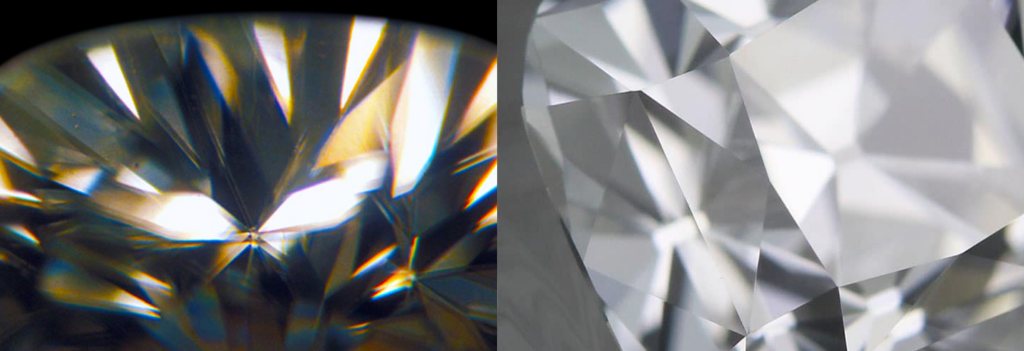
Moissanite vs Diamond Under Magnification
Both moissanite and diamond can be colorless or near-colorless. The amount of color a moissanite has depends upon the type of moissanite. Classic moissanite, the first moissanite that man created, is a greenish-yellow hue. It’s not very pretty, and Do Amore does not sell it. In fact, many feel that classic moissanite’s color is similar to a GIA-certified K-color diamond (quite yellow). On the other hand, Forever One Moissanite can be colorless or near colorless! Forever One Colorless has the color of a GIA-certified E-color diamond. Forever One Near Colorless has the color of a GIA-certified I-color diamond. Both of these gems are gorgeous, come in a variety of sizes, and make perfect engagement stones.
No. Forever Brilliant was near colorless, Forever One can be colorless! Have you been looking around and seeing “Forever Brilliant” Moissanite mentioned? Wondering what is Forever Brilliant Moissanite is? Forever Brilliant was Charles & Colvard’s first attempt at a colorless-looking Moissanite. However, because the technology wasn’t as great back then, it turned out near colorless. As a result, when Charles & Colvard developed Colorless Moissanite (what everyone really wanted to begin with), they called it Forever One.
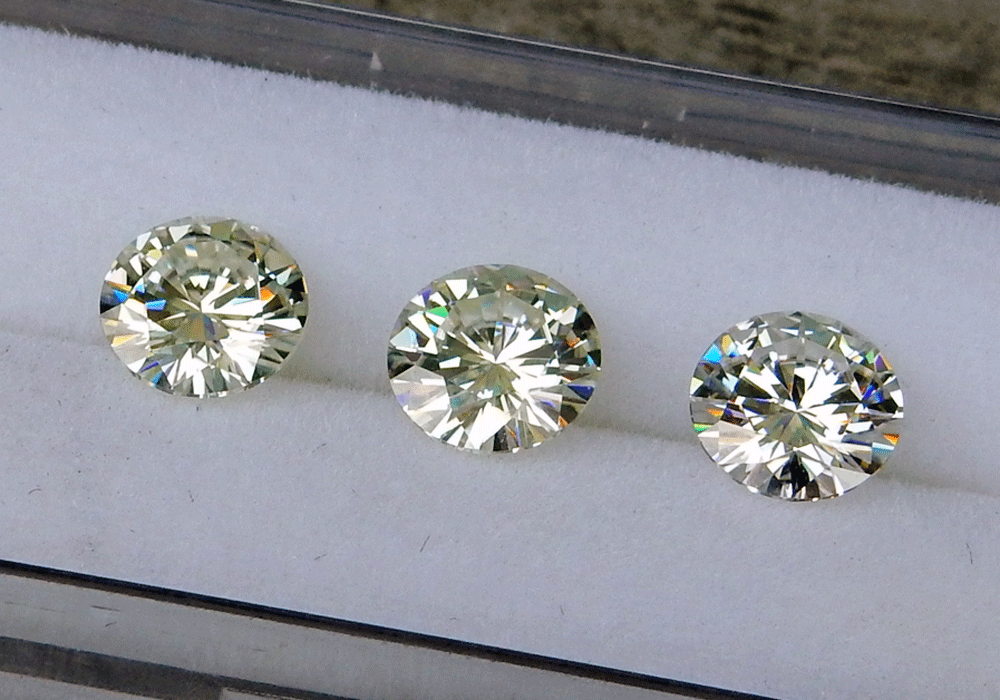
Classic Moissanite (left) vs Near Colorless Moissanite (center) vs Forever One Colorless Moissanite (right)
Colorless Forever One Moissanite is widely thought to be more beautiful than near colorless Forever Brilliant was. So, we highly recommend choosing a crisp and icy Forever One colorless for your engagement ring! However, if you’re looking for the warmth of a near colorless, Do Amore can special order a Forever One Near Colorless for you, too!
Hot Tip: Classic & Near-colorless moissanite is still sold by numerous jewelers. So, to make sure you don’t get stuck with a yellow-green classic moissanite or only a near-colorless stone, demand Forever One Colorless!
VIEW OUR FOREVER ONE MOISSANITE COLLECTION>
Forever One Colorless Hearts & Arrows looks most like a diamond as it’s cut to show even white and rainbow sparkle! Non Hearts & Arrows Moissanite will show more rainbow sparkle than white. Hearts & Arrows Moissanite is only faceted in round and cushion shapes, currently. Other shapes that look more similar to diamond include emerald and asscher, as these shapes do not truly “sparkle”, and instead have more of a sheen.
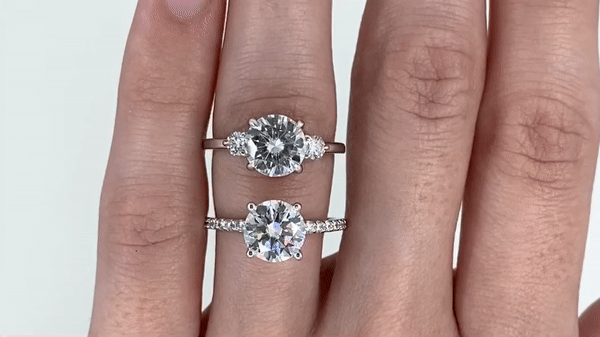
Forever One Moissanite (top) VS Hearts & Arrows Forever One Moissanite (bottom)
Moissanite is a very hard gem, but not quite as hard as diamond. The harder a material, the more difficult it is to scratch. And, on the Mohs Scale of Hardness, moissanite is rated as a 9.25. This is a great score, and higher than any gemstone used in jewelry besides diamonds! Diamonds, which are the hardest known mineral, score a 10.
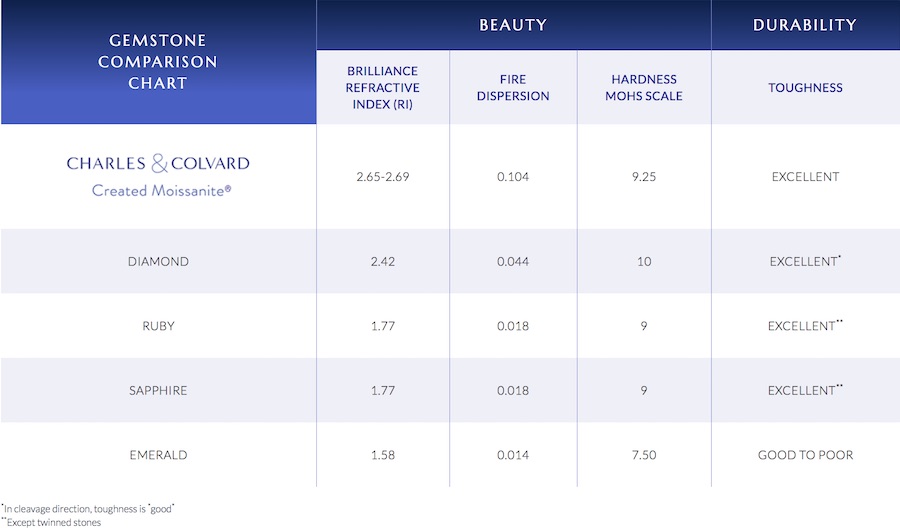
Yes! Moissanite’s great hardness makes it an ideal ring to wear everyday! At a 9.25 hardness, it stands up to wear and tear extremely well, making it a great engagement ring choice. Also, Moissanite’s mineral makeup means that it resists oil and dirt better than a diamond.
Moissanite resists chipping and breaking better than diamond. Diamond, when struck against something hard, can sheer off in the direction of its crystal growth (this is called “cleaving”). Moissanite, on the other hand, does not break in its crystal direction, as its cleavage in “indistinct”. This means that while a Moissanite can still be chipped, it is less prone to large breaks than diamond is.
Yes, but only by the rare things harder than it, like diamonds and certain abrasive cleaners. However, that’s about all that can scratch a moissanite! Most other gems and surfaces, such as sapphire or granite, are softer than Moissanite and cannot cause scratches. Because Moissanite is a 9.25 on the hardness scale, and diamond is a 10, diamond can scratch moissanite.
Overall, moissanite is a fraction of the cost of a diamond. Also, while a diamond’s price varies based on cut, clarity, and other individual characteristics, moissanite varies only with type and size. Below is a table comparing our pricing for a GIA-certified round diamond (with I-color and VS2 clarity), a classic moissanite stone (not colorless), a near-colorless moissanite stone, and Forever One colorless moissanite stone.
| Carat Size | GIA Certified Diamond (Round, I-color, VS2) | Classic Moissanite | Near Colorless Moissanite | Forever One Colorless Moissanite |
| .5 | $1,100+ | $89 | $243 | $269 |
| 1.0 | $4,000+ | $269 | $539 | $599 |
| 1.5 | $10,000+ | $449 | $945 | $1,049 |
For those who want a big blingy look for a reasonable price, yes! Many of our customers choose Moissanite over diamond when they want a great ring look, but also want to buy a house. Moissanite is a great option for couples on a budget, those looking for a man-made option for sustainable reasons, or those who simply do not feel the need to spend a lot on a ring. We have thousands of very happy moissanite customers!
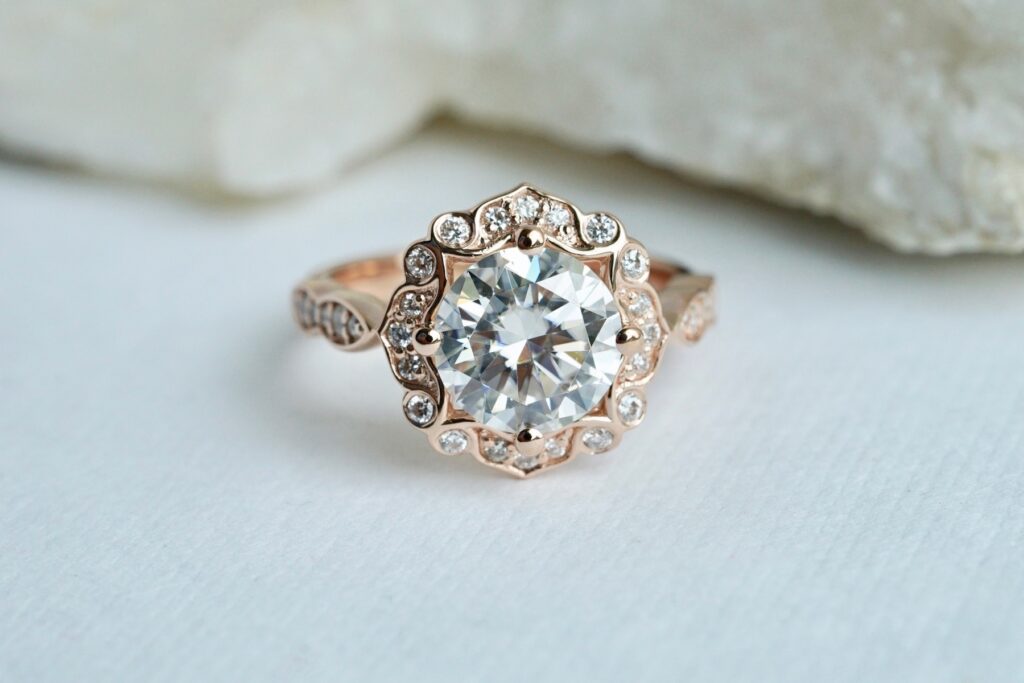
Moissanite engagement ring
While moissanite does not replicate the look of a diamond exactly, it is a beautiful, durable, white stone! So, it’s a viable option for those not wanting to purchase a diamond. Colored stones, like sapphires (which also come in white!), are beautiful options as well. As a result, there are many ways we can help couples create a stunning ring without paying for the higher cost of a diamond.
To pair an engagement ring with a moissanite, find your favorite engagement ring here, then choose “Pair with Moissanite.”
Of course! Do Amore is proud to be knowledgeable in conflict-free diamonds, moissanite, and other stone options so please feel free to contact us with any questions. Feel free to ask for me personally (my name is Krish)!
Choosing between white sapphire vs diamond is one of the more common dilemmas our couples come up against. How to choose? Can you tell the difference? What is the benefit to choosing diamond vs white sapphire anyway? While both of these stones are beautiful, natural, and durable – there are some major differences between them, too! Find out which gem is right for you below!
Yes. There is a huge visual difference between Diamond vs White Sapphire. While both gems are colorless (or “white”), they differ quite noticeably in terms of their “brilliance” (white sparkle) and “fire” (colored sparkle). Also, they differ in terms of how they handle dirt and oil. That said, each gem has its own unique look and beauty!
No. White Sapphire’s sparkle is a silvery white-gray, whereas Diamond’s sparkle is rainbow colored with some white mixed in. This is due to Diamond’s high refractive index and dispersion (two measures for how a gemstone handles light). Remember those prisms you played with as a kid? Just like that! So, White Sapphire handles light by returning a more muted silvery sparkle. And, Diamond handles light by returning a rainbow of glittering sparkle. This is important in terms of look, as well as planning for ring cleaning/upkeep. In other words, a Diamond’s high Refractive Index (RI) allows it to sparkle through dirt and oil, whereas White Sapphire’s lower RI means it need more regular cleaning to keep it brilliant.
| Refractive Index (White Light) | Dispersion/Fire (Colored Light) | |
| Diamond | 2.42 | .04 |
| White Sapphire | 1.77 | .018 |
You can tell a White Sapphire from a Diamond, CZ, and Moissanite by its more muted, silvery sparkle. It’s also way heavier! You can tell White Sapphire from other white gemstones, such as White Topaz, Rock Crystal (White Quartz), or Paste (white glass used in jewelry) by its crisp facet edges. That is because White Sapphire is an incredibly hard gemstone at 9/10 on the Mohs Hardness Scale! So, it stands up to wear and tear much better than Topaz, Quartz, or Paste (which will show micro chipping called “abrasion” on its facet edges more readily).
Side by side, White Sapphire looks less brilliant than Diamond. Next to White Sapphire, Diamond’s sparkle appears much more colorful.
In order to choose the right stone, couples should consider what “look” they are going for. Is it sparkle? What kind of sparkle? Or do you want a big size? Ease of wear? How does cost factor in?
White Sapphire is elegant, durable, comes in large sizes, and is incredibly affordable. In addition, those who believe in gemstone lore will love White Sapphire for its ability to bring clarity to your mind. Finally, Sapphire has a royal pedigree, bringing a unique level of sophistication to a White Sapphire engagement ring.
Diamond is mega brilliant, supremely durable, highly sought after, and shines through dirt, oil, and even in low light. Those who love gemstone powers will also love that Diamond brings you strength. Finally, given Diamond’s legacy as the gift of love and status, a Diamond also carries with it better long-term investment potential.
The biggest drawbacks to White Sapphire are lower sparkle and need for more frequent cleaning to keep it brilliant. But, in exchange, you get a larger stone for less money.
Cost! Diamonds are significantly more money than White Sapphire, and you get a smaller stone for your dollar. However, in exchange, you get much more brilliance and ease of wear.
Ah, the $64,000 question! White Sapphire is significantly less expensive than Diamond!
| Carat Size | GIA Certified Diamond (Round, I-color, VS2) | White Sapphire |
| .50ct (5mm) | $1,100+ | $430 |
| 1.0ct (6.5mm) | $4,000+ | $980 |
| 1.5ct (7.5mm) | $10,000+ | $1,680 |
Another common question we get is whether a couple should choose White Sapphire or Moissanite. It’s a great question because both gems are fantastic diamond alternatives! Both of these colorless stones offer superior hardness and lovely sparkle at a fraction of the cost of Diamond.
It depends. Couples looking for a natural diamond alternative should choose White Sapphire. That is because White Sapphire grows in the Earth’s crust, and it’s naturally white, too (so, it’s untreated, unlike most blue sapphire)! On the other hand, Moissanite is a man-made gem. So, if natural origin or rarity is important to you, White Sapphire is a great option.
Those looking for extreme sparkle and fire should choose Moissanite! As White Sapphire gives off a more subtle, silvery glint, couples looking for knock-your-socks-off pizzazz should definitely choose Moissanite. Its high refractive index and dispersion means it will sparkle from across the room!
Side by side, White Sapphire will look more light gray than white. Next to White Sapphire, Moissanite looks like a firework.
It depends (I know, your favorite answer)! Cubic Zirconia is the most common diamond alternative out there, and one of the least expensive. However, it is a man made gemstone, while also being less durable and less brilliant than Moissanite. So, against the standards above of rarity and brilliance, CZ doesn’t win either contest. As a result, we choose not to sell CZ and would recommend White Sapphire or Moissanite.
We sure can! Send us a message here or email us at care@doamore.com! Feel free to ask for me, Corinne, the gemologist. I’d be happy to walk you through it and help you make the right decision for your ring!
Looking for a sustainable diamond alternative for your engagement ring? You’re in good company. Many couples today are looking for something other than diamond to signify their bond. As a result, there’s a bunch of diamond alternatives to consider! Whether you want to ensure your gem is conflict-free, you want to spend less, or you just want to buck the norms, we’re here for ya. Read on to see what the newest and best diamond alternatives are in 2020!
Well, it can mean different things to different people. In this post, we’re going to review white-colored gemstones that couples are using instead of natural mined diamonds. We think this will help couples that want a colorless look, without the mined diamond price. We have lots of couples that love this option! However, if you’re looking for something more colorful in your diamond alternative, there are also plenty of gemstone engagement ring options we love, too!
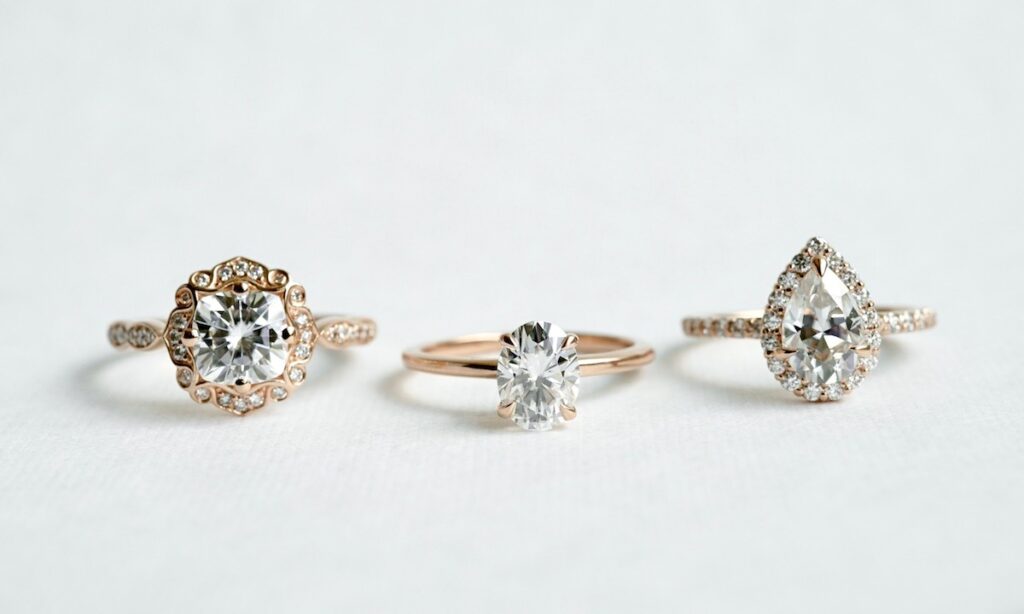
Left: Victoria with 7mm Cushion Moissanite | Middle: Mae with 8x6mm Oval Moissanite | Right: Elle with 9x6mm Pear Moissanite
Lab Created Diamonds are the newest (and best) alternative to a natural, mined diamond. And they’re gorgeous. This is because Lab Diamonds are actually the same mineral as natural mined diamonds. The only difference is that they were born in a lab instead of the ground.
So why is it the best “diamond alternative”? Looks, hardness, and price. Lab Created Diamonds have the exact same chemical makeup as mined diamonds (not true for any other diamond alternative). Both lab diamonds and mined diamonds are pure carbon, they sparkle exactly the same, and they have the same 10/10 hardness. The only way you can tell a Lab Grown Diamond from a mined Diamond is to have it gemologically tested! I mean, I’m not sure it gets any better than this, guys. You get a real diamond for 30-50% of the price of a natural, mined stone of the same quality.
Gone are the days that “synthetic diamonds” were off-color or highly included. New scientific breakthroughs have been made and Lab Diamonds are now white, eye clean, and indistinguishable from mined stones! Check out Do Amore’s extensive selection of ethical Lab Diamonds here.
Man-Made Diamonds get you the exact look you want, and the price you would prefer to pay. They are the ultimate mined diamond alternative.
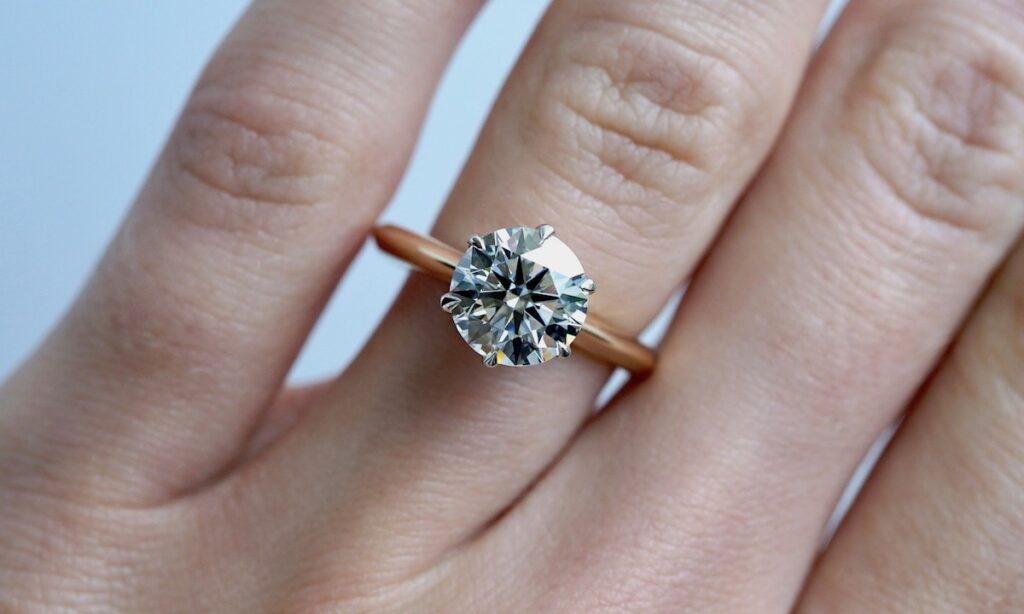
Two-tone Luna Engagement Ring with 2.2ct Lab-Created Diamond
For those looking for an even more blingy diamond alternative, Moissanite is a great pick. Because of its extreme “dispersion,” Moissanite sparkles even more than a diamond. And, it’s also incredibly hard at 9.25/10 on the Mohs Hardness Scale. This means that it will stand up to daily wear very well (only surpassed by diamond)! Finally, Moissanite is only a fraction of the price of Lab Diamonds, making it very affordable.
For those who may have had yellow-tint complaints about Moissanite in previous years, listen up! New advancements have been made, and gem scientists have created completely colorless Moissanite! I know! I was as shocked as you. Forever One Moissanite is as colorless as an E color diamond – and quite stunning – check out Do Amore’s wide range of it here.
Moissanite is a great diamond alternative. Those choosing Moissanite should expect sparkle that looks like fireworks (way more than diamond).
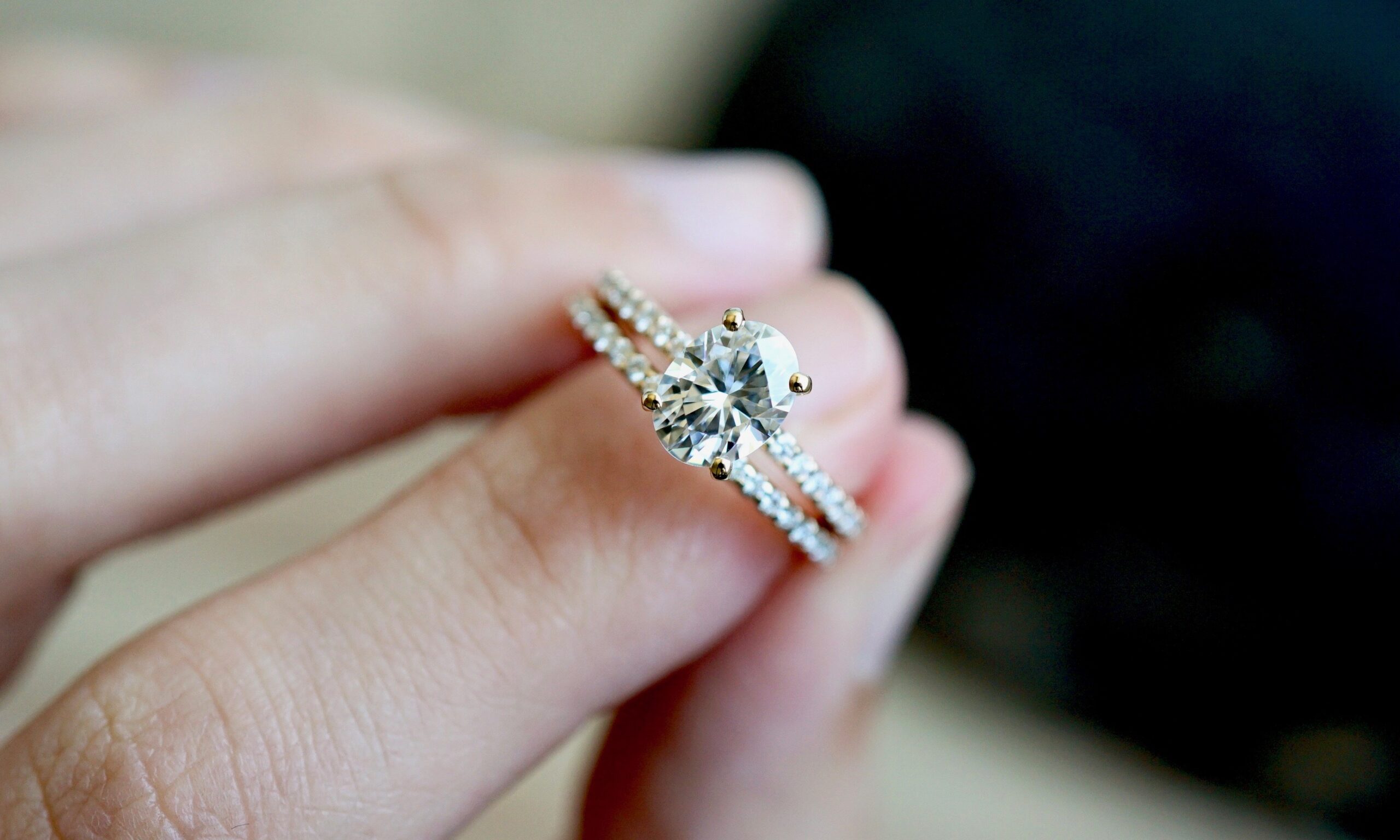
Diana Engagement Ring Set with an 8x6mm Oval Moissanite
For those of you looking for a natural diamond alternative, White Sapphire is a great pick. This is because White Sapphire is natural, durable, beautiful, and super affordable! Sapphire is a 9/10 on the hardness scale. In other words, a White Sapphire will stand the test of time (and your daily life). It also comes in a range of shapes and sizes – and some can be pretty huge!
One unique thing about White Sapphire is that, in addition to being natural, it is often not treated at all. What I mean by “treated” is that most Sapphire out there is heated before being cut, in order to improve its color and clarity. So, for those out there who are natural gem snobs (I can appreciate that), White Sapphire’s lack of heat treatment offers some serious bragging rights. And, who doesn’t want bragging rights in their engagement ring?!
White Sapphire is the clear winner in terms of a natural diamond alternative. Those choosing White Sapphire should expect white sparkle only as compared with the white and colored sparkle diamond offers. Check out Do Amore’s White Sapphire collection here.
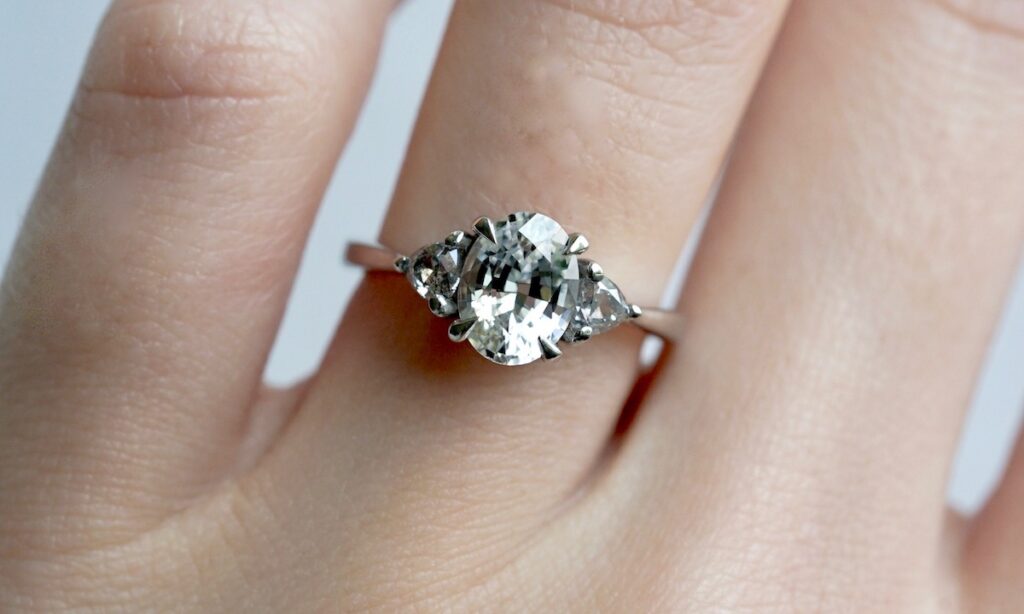
Custom Engagement Ring with 8x6mm Oval White Sapphire
I would be remiss if I left out White Topaz! For those looking for serious value, White Topaz is the way to go. That is because Topaz is natural, durable, and incredibly inexpensive. With its cool grey-white sparkle, White Topaz offers a refined, elegant look. It also comes in some seriously big sizes, for those looking for a huge impact. White Topaz’s 8/10 hardness on the Mohs Hardness Scale additionally means that it avoids scratching pretty well. Couples choosing White Topaz should make sure to pick a protective setting, like a bezel, 6-prong, or halo to ensure it stays beautiful forever.
Adding a top AAA-quality one carat White Topaz to any of Do Amore’s ethical engagement ring settings will set you back less than $200! While White Topaz is not listed on Do Amore’s website, we have access to some of the most beautifully faceted top AAA-quality White Topaz in the world. If you want one, email us here. We’ll look through at least ten White Topaz of your chosen shape and size and choose the most beautiful for your ethical engagement ring.
Want a huge look for little money? White Topaz is the diamond alternative for you. However, make sure to set it in a protective setting. Those choosing White Topaz should expect grey-white sparkle, as compared with diamond’s white and colored sparkle.
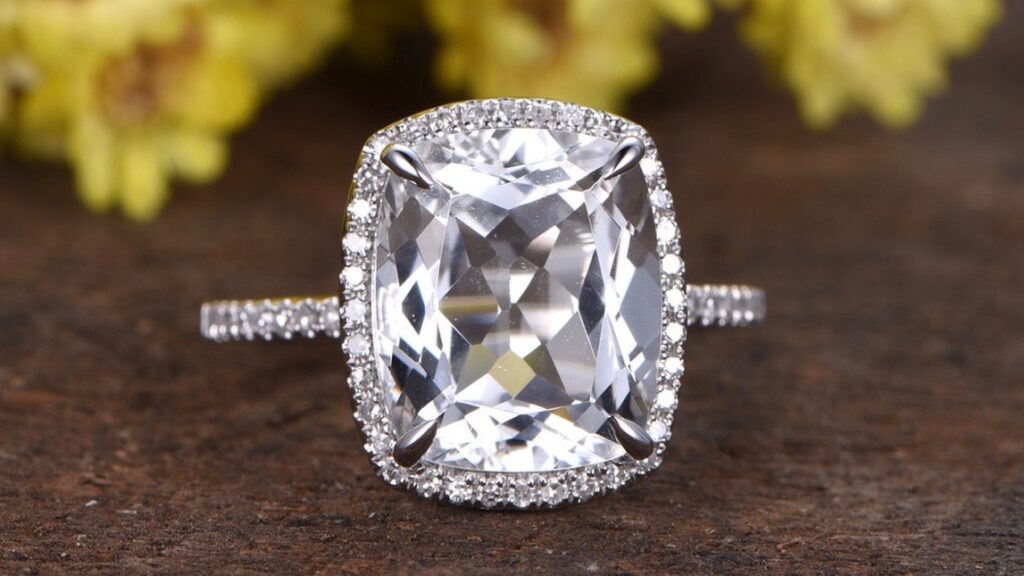
Here’s a handy comparison chart. Don’t know which one to choose? That’s alright. Email us here and we’ll help!
| Look | Hardness | Price (1 carat Round) | |
| Lab Diamond | 100% Diamond! | 10/10 | $2,400 – $3,500 |
| Moissanite | More Sparkly Than Diamond | 9.25/10 | $599 |
| White Sapphire | All White Sparkle | 9/10 | $980 |
| White Topaz | White & Gray Sparkle | 8/10 | <$200 |
Sure! The best way for me to help you get exactly what you want is for you to tell me what your priorities are. Why do you want a diamond alternative? Is it for sustainability reasons? Cost? Look? Send us a note here, or email me here (my name is Corinne) and tell me the story of your love! I will help you pick the perfect diamond alternative for your ring!